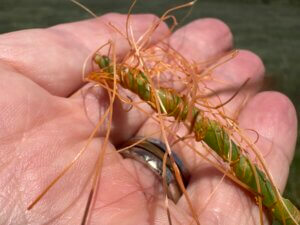
Spaghetti Season in the Marsh
In summer, look for the weird, netlike mats of bright orange saltmarsh dodder.
Eek! Silly string is taking over salt marshes at China Camp! Okay, it’s not silly string, but the orange strands of an odd summer visitor that looks like aerosol streamers shot from a can at a kid’s birthday party. This freaky-looking mesh is saltmarsh dodder, which begins to creep and crawl over the tops of pickleweed plants in May.
As saltmarsh dodder grows, it forms spongy, netlike webs that get so thick that they create impressive, tangerine-bright patches in the otherwise green marsh. Look for them in the broad stretches of salt marsh across from Back Ranch Meadows and Miwok Meadows.

So what exactly is this brightly-hued curiosity? Saltmarsh dodder (Cuscuta salina var. major) is a parasitic plant that lives off nutrients stolen from other plant species. Occurring naturally in the San Francisco Bay Area, saltmarsh dodder is actually a member of the morning-glory family (Convolvulaceae). Like morning glories, it flowers and produces seeds like a “normal” plant. But similarities end there, since the dodder’s sprouting seedlings generally forego rooting in the ground. Instead, parasitic dodder sends out rootlike structures, called haustoria, from its stem. These “air roots” seek out and penetrate the cell walls of the host plant—typically pickleweed at China Camp. Once attached, the dodder starts absorbing water and nutrients from the host without killing it.
Other types of dodder thrive in our region, and worldwide there are roughly 200 species of Cuscuta, all of them parasitic. Many species, though native, are considered pests since they use cultivated crops, such as alfalfa, citrus, and peach trees, as hosts. The saltmarsh dodder that thrives at China Camp occurs in salty locations from British Columbia south to the Mexican border. Though it tends to latch on to pickleweed plants, saltmarsh dodder also uses other species, like alkali weed and seablite, as host plants.
You probably won’t be able to get close to saltmarsh dodder at China Camp, since it’s illegal to enter our tidal wetlands. But if you could, you’d notice that the spaghetti-like strings have tiny nub-like scales that are all that’s left of the plant’s nonfunctioning leaves. Small clusters of flowers—just ¼-inch wide—burst out from the tips of the stringy stems, opening a starburst of nearly translucent white petals. By late summer (dodder typically grows until the end of September), the plant has produced small, white, berry-like capsules, each carrying a single seed. These seeds sprout in spring to start the cycle again. In our mild climate, adult plants can also overwinter and flourish again once temperatures begin to rise.
So keep your eyes peeled for this marshland oddity, also known by a host of colorful monikers, including devil’s guts, strangleweed, witch’s shoelaces, hairweed, hellbine, love vine, pull-down, strangleweed, strangle gut, and witches hair. Whatever you call it, it’s a freaky summertime resident that adds unexpected color to our tidal wetlands.
—by Harriot Manley/FOCC volunteer

